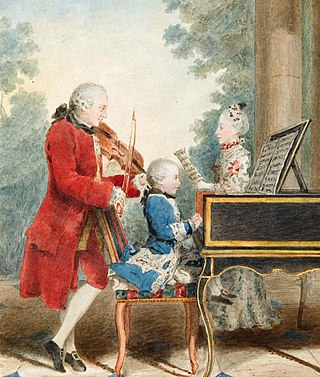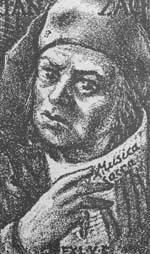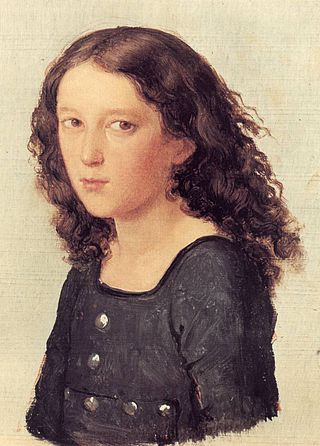Related Research Articles

The Classical Period was an era of classical music between roughly 1750 and 1820.

An orchestra is a large instrumental ensemble typical of classical music, which combines instruments from different families. There are typically four main sections of instruments:

Wolfgang Amadeus Mozart was a prolific and influential composer of the Classical period. Despite his short life, his rapid pace of composition resulted in more than 800 works representing virtually every Western classical genre of his time. Many of these compositions are acknowledged as pinnacles of the symphonic, concertante, chamber, operatic, and choral repertoire. Mozart is widely regarded as one of the greatest composers in the history of Western music, with his music admired for its "melodic beauty, its formal elegance and its richness of harmony and texture".

In music, a cadenza, is, generically, an improvised or written-out ornamental passage played or sung by a soloist(s), usually in a "free" rhythmic style, and often allowing virtuosic display. During this time the accompaniment will rest, or sustain a note or chord. Thus an improvised cadenza is indicated in written notation by a fermata in all parts. A cadenza will usually occur over either the final or penultimate note in a piece, the lead-in, or the final or penultimate note in an important subsection of a piece. A cadenza can also be found before a final coda or ritornello.
A concerto is, from the late Baroque era, mostly understood as an instrumental composition, written for one or more soloists accompanied by an orchestra or other ensemble. The typical three-movement structure, a slow movement preceded and followed by fast movements, became a standard from the early 18th century.

Carl Philipp Emanuel Bach, also formerly spelled Karl Philipp Emmanuel Bach, and commonly abbreviated C. P. E. Bach, was a German galant composer and musician, the fifth child and second surviving son of Johann Sebastian Bach and Maria Barbara Bach.

Paul Sacher was a Swiss conductor, patron and billionaire businessman. At the time of his death Sacher was majority shareholder of pharmaceutical company Hoffmann-La Roche and was considered the third richest person in the world with an estimated net worth of US$13 billion.

Jan Zach, called in German Johann Zach was a Czech composer, violinist and organist. Although he was a gifted and versatile composer capable of writing both in Baroque and Classical idioms, his eccentric personality led to numerous conflicts and lack of steady employment from about 1756 onwards.
The siciliana or siciliano is a musical style or genre often included as a movement within larger pieces of music starting in the Baroque period. It is in a slow 6
8 or 12
8 time with lilting rhythms, making it somewhat resemble a slow jig or tarantella, and is usually in a minor key. It was used for arias in Baroque operas, and often appears as a movement in instrumental works. Loosely associated with Sicily, the siciliana evokes a pastoral mood, and is often characterized by dotted rhythms that can distinguish it within the broader musical genre of the pastorale.
A ritornello is a recurring passage in Renaissance music and Baroque music for orchestra or chorus.

Neoclassicism in music was a twentieth-century trend, particularly current in the interwar period, in which composers sought to return to aesthetic precepts associated with the broadly defined concept of "classicism", namely order, balance, clarity, economy, and emotional restraint. As such, neoclassicism was a reaction against the unrestrained emotionalism and perceived formlessness of late Romanticism, as well as a "call to order" after the experimental ferment of the first two decades of the twentieth century. The neoclassical impulse found its expression in such features as the use of pared-down performing forces, an emphasis on rhythm and on contrapuntal texture, an updated or expanded tonal harmony, and a concentration on absolute music as opposed to Romantic program music.
In music, galant refers to the style which was fashionable in the upper-class societies of Western Europe from the 1720s to the 1770s.
Giuseppe Francesco Gaspare Melchiorre Baldassare Sammartini was an Italian composer and oboist during the late Baroque and early Classical era. Although he was from Milan, most of his professional life was spent in London and with Frederick, the Prince of Wales. He also had a younger brother, Giovanni Battista Sammartini, who likewise became a renowned composer.
Johann Ludwig Krebs was a German Baroque musician and composer for the pipe organ, harpsichord, other instruments and orchestras. His output also included chamber music, choral works and concertos.

Classical music generally refers to the art music of the Western world, considered to be distinct from Western folk music or popular music traditions. It is sometimes distinguished as Western classical music, as the term "classical music" can also be applied to non-Western art musics. Classical music is often characterized by formality and complexity in its musical form and harmonic organization, particularly with the use of polyphony. Since at least the ninth century it has been primarily a written tradition, spawning a sophisticated notational system, as well as accompanying literature in analytical, critical, historiographical, musicological and philosophical practices. A foundational component of Western culture, classical music is frequently seen from the perspective of individual or groups of composers, whose compositions, personalities and beliefs have fundamentally shaped its history.

The Piano Concerto No. 6 in B-flat major, K. 238, was composed by Wolfgang Amadeus Mozart in January 1776. His Concerto No. 7 for three pianos and his Concerto No. 8 in C major would follow within three months. The three works share what Cuthbert Girdlestone refers to as a galant style.
Joseph Haydn's Keyboard Concerto No. 11 in D major was written between 1780 and 1783. It was published in 1784. It is his last concerto for a keyboard instrument.

Baroque music refers to the period or dominant style of Western classical music composed from about 1600 to 1750. The Baroque style followed the Renaissance period, and was followed in turn by the Classical period after a short transition. The Baroque period is divided into three major phases: early, middle, and late. Overlapping in time, they are conventionally dated from 1580 to 1650, from 1630 to 1700, and from 1680 to 1750. Baroque music forms a major portion of the "classical music" canon, and is widely studied, performed, and listened to. The term "baroque" comes from the Portuguese word barroco, meaning "misshapen pearl". The works of George Frideric Handel and Johann Sebastian Bach are considered the pinnacle of the Baroque period. Other key composers of the Baroque era include Claudio Monteverdi, Domenico Scarlatti, Alessandro Scarlatti, Alessandro Stradella, Tomaso Albinoni, Johann Pachelbel, Henry Purcell, Antonio Vivaldi, Georg Philipp Telemann, Jean-Baptiste Lully, Jean-Philippe Rameau, Marc-Antoine Charpentier, Arcangelo Corelli, François Couperin, Johann Hermann Schein, Heinrich Schütz, Samuel Scheidt, Dieterich Buxtehude, Gaspar Sanz, José de Nebra, Antonio Soler, Carlos Seixas and others.

The Concerto for Piano, Violin, and Strings in D minor, MWV O4, also known as the Double Concerto in D minor, was written in 1823 by Felix Mendelssohn when he was 14 years old. This piece is Mendelssohn's fourth work for a solo instrument with orchestral accompaniment, preceded by a Largo and Allegro in D minor for Piano and Strings MWV O1, the Piano Concerto in A Minor MWV O2, and the Violin Concerto in D minor MWV O3. Mendelssohn composed the work to be performed for a private concert on May 25, 1823 at the Mendelssohn home in Berlin with his violin teacher and friend, Eduard Rietz. Following this private performance, Mendelssohn revised the scoring, adding winds and timpani and is possibly the first work in which Mendelssohn used winds and timpani in a large work. A public performance was given on July 3, 1823 at the Berlin Schauspielhaus. Like the A minor piano concerto (1822), it remained unpublished during Mendelssohn's lifetime and it wasn't until 1999 when a critical edition of the piece was available.
The Concerto for Flute and Orchestra was written by Josef Reicha in 1781, shortly after he went on a Grand Tour in the mid to late 1770s. Though the work was composed in 1781, far beyond the date music historians have deemed as the beginning of the classical era, it displays many characteristics of the galant musical style characteristic of the pre-classical post-Baroque music of the eighteenth century. Records do not indicate whether Reicha began composing the work while he was visiting the cosmopolitan centers of Europe but we may assume that he was indeed inspired by what he heard and saw based on the prevalence of galant musical characteristics presented throughout the work including (1) a simplistic, song-like, and clear melody, (2) short and periodic phrases, (3) a reduced harmonic vocabulary that emphasizes tonic and dominant, and (4) a clear distinction between soloist and accompaniment.
References
- ↑ Daugherty, James F. "The Classical Period (1775-1825)". University of Kansas . Retrieved 2014-02-24.
- ↑ Hoffer, Charles (2012). Music Listening Today (4 ed.). Cengage Learning. p. 123. ISBN 9780495916147. LCCN 2010940572 . Retrieved 2014-02-24.
- ↑ Bachus, Nancy, ed. (2006-07-01). The Baroque Piano: The Influence of Society, Style, and Musical Trends on the Great Piano Composers. Alfred Music. p. 69. ISBN 0739042955 . Retrieved 2014-02-24.
- ↑ "Style Galant". Lcsproductions.net. Retrieved 2014-02-24.
- ↑ White, Chappell (1994). From Vivaldi to Viotti: A History of the Early Classical Violin Concerto. Gordon and Breach. p. xiv. ISBN 2881244955 . Retrieved 2014-02-24.
- ↑ Daniel, Ralph Thomas. "Western music: The sonata and concerto". Encyclopædia Britannica . Retrieved 2014-02-24.